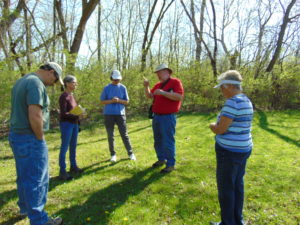Tiptoeing through the spring wildflowers
By Anne Eickstadt

ANNE EICKSTADT PHOTO Belvidere Daily Republican
BCCD volunteer Brian Hale identifies wildflowers throughout Kinnikinnick Creek Conservation Area.
Editor
Kinnikinnick Creek Conservation Area drew a select group of people on Saturday, May 5 to learn about identifying wildflowers from the Boone County Conservation District. BCCD volunteer Brian Hale led the group around the parking area and deep into the woods to locate and identify wild spring flowers. “He’s a former board member and our best plant guy,” said BCCD education director Tina Dawson Scott.
Hale first discussed various plant guidebooks and how to use them. He explained terms commonly used in identifying plants, such as ‘entire’ in describing a leaf with a smooth edge, ‘lobed’, ‘toothed’, and ‘divided’ or ‘compound’. A plant’s leaves will be one of the main clues used to identify the plant if the flower is not yet in bloom.
Petals can be ‘regular’, ‘irregular’, or ‘composite’.
Location is also an excellent clue as some flowers do well in sunshine, others do well in shade, and still others like a happy mix of sunshine and shade. Some plants grow nearly anywhere while others will only be found in quality, undisturbed land. Some plants like dryer locations and some prefer damp, or downright soggy, areas.
Hale divided the head of a dandelion to demonstrate that it is not a single flower but a multitude of tiny flowers that make up the floral portion of the plant. He explained how the dandelion is related to the sunflower and so is the aster.
Hale pointed out a yellow flower, “Go to the yellow section of your guidebook,” he said. “This one has shiny petals and divided leaves. That means it’s an early buttercup.
“Oh, great,” he said. “I pick one to show you and I pick the weird one. This one has six lobes, while normally they have five. This is the type of thing you have to be alert for because the weird ones can fool the guidebook.
“You won’t see a prairie flower in a woodland or a woodland flower in a prairie.”
He started by identifying the wood anemone, violet, and dandelion then headed into the woods for shyer flowers. “The common blue violet grows anywhere,” he said. “The hairy, yellow violet only grows in a quality woodlands. May apples only grow where they are not disturbed.”
Wild geranium, Virginia waterleaf, red or prairie trillium, trout lily, declined trillium, white trillium, bedstraw, jack in the pulpit, skunk cabbage, bloodroot, and shooting star, Jacob’s ladder, swamp buttercup, flowering bellwort, bishop’s cap (miterwort) early meadowroot were all pointed out and discussed. “Sharp-lobed hepatica comes in different colors and can fool the book,” Hale said. “You can also have white, blue, and pink hepatica growing in a small area.”
“Honeysuckle, garlic mustard, and multiflora rose are intrusive species,” he said and can destroy…
For complete article, pick up the May 16 BDR.


